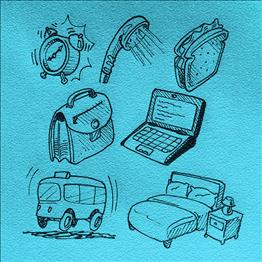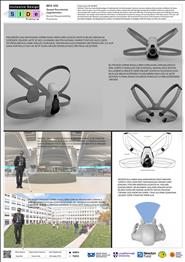Loading
My Buddy

DESIGNED BY:
Miray Desenci, Raziye Nevra Okumuş, Sena Dalabasmaz, Ezgi Altun, Kevser Çalık, Elif Aybaş (SDFB)
INTRODUCTION:
Within the scope of the project, the positive aspects and deficiencies related to the user experience of white cane of our visually impaired NGO design partner were examined in detail. Our NGO partner has stated that people with disabilities find using white canes positive because it allows them to see their next step, feel safe, and make others around them know that they are visually impaired. Our NGO partner has also stated that white canes are insufficient in perceiving obstacles at eye level, causing inconvenience due to occupying one hand, and incapable of informing the target’s direction. The interviews have enabled us to determine that the purpose of using the white cane was beyond assisting visually impaired individuals while walking and that they had an essential function in giving the user a sense of safety.
In the first phase of the design process, the problems experienced by visually impaired individuals and their interaction with the white cane were examined, and it was decided that there was no benefit in using the product and a completely new solution should be devised. However, it was later concluded that it would be difficult for people to leave the white cane, which has been in use for such a long time and start using another product. It could also be stated that the sense of safety that comes up after the interaction of the user with the white cane is an emotional function of the product. Instead, based on the shortcomings of the white cane, a design scenario that can increase autonomy and which could also perhaps reduce or eliminate the need for white canes, in the long run, was focussed.
MY BUDDY PROJECT:
Although this project, which aims to build a more independent and autonomous life for visually impaired people, focuses on movement without a white cane, it initially included developing a scenario where users could first get used to the suggested system in an indoor space. The system has thus been specifically designed for airports.
Airports are one of the public structures where people can enter freely and spend only part of daily life unless they work there. These structures are at the same time quite large in volumes as necessitated by their function. They are structures where individuals without any visual impairment can easily get lost, have problems finding direction, and horizontal and vertical circulation flow is difficult to follow. Therefore, it was aimed that the design concept would be turned into an application which can also be used by individuals without any visual impairment. It was decided that the horizontal and vertical circulations will be depicted through visual diagrams or voice instructions based on user preference.
The technological materials used to develop the design are as follows: a microprocessor, a lidar sensor, a vibration device, a headset, and a speaker. The technological functioning of the suggested design is as follows:
CONCLUSION:
This wearable technology we designed could minimise the need for a white cane as much as possible or make it unnecessary in the long run, and it will allow individuals with visual impairment to move more freely because they will be able to use both their hands while carrying luggage or similar objects. Thanks to the three-dimensional sensory feature of the Lidar sensor, the distance of the target point (stairs, elevator) and information on its direction will also be transferred to the disabled individual. This information, which cannot be provided with a white cane, will encourage product’s use. Since the existing systems work online, there might be problems like loss of connection. The updated three-dimensional data of the related structure will be recorded in our design for resolving this issue.
The recommended solution will make users feel safe by adding design features a white cane cannot offer but needed by visually impaired individuals. The solutions we rolled out for the issues faced in similar technologies will encourage using the system we developed. The high wearable technology that we designed will enable visually impaired individuals to move around airports freely and in a controlled way without needing another person’s assistance. The proposed system also has the potential to be used in other closed areas other than airports.
Miray Desenci, Raziye Nevra Okumuş, Sena Dalabasmaz, Ezgi Altun, Kevser Çalık, Elif Aybaş (SDFB)
INTRODUCTION:
Within the scope of the project, the positive aspects and deficiencies related to the user experience of white cane of our visually impaired NGO design partner were examined in detail. Our NGO partner has stated that people with disabilities find using white canes positive because it allows them to see their next step, feel safe, and make others around them know that they are visually impaired. Our NGO partner has also stated that white canes are insufficient in perceiving obstacles at eye level, causing inconvenience due to occupying one hand, and incapable of informing the target’s direction. The interviews have enabled us to determine that the purpose of using the white cane was beyond assisting visually impaired individuals while walking and that they had an essential function in giving the user a sense of safety.
In the first phase of the design process, the problems experienced by visually impaired individuals and their interaction with the white cane were examined, and it was decided that there was no benefit in using the product and a completely new solution should be devised. However, it was later concluded that it would be difficult for people to leave the white cane, which has been in use for such a long time and start using another product. It could also be stated that the sense of safety that comes up after the interaction of the user with the white cane is an emotional function of the product. Instead, based on the shortcomings of the white cane, a design scenario that can increase autonomy and which could also perhaps reduce or eliminate the need for white canes, in the long run, was focussed.
MY BUDDY PROJECT:
Although this project, which aims to build a more independent and autonomous life for visually impaired people, focuses on movement without a white cane, it initially included developing a scenario where users could first get used to the suggested system in an indoor space. The system has thus been specifically designed for airports.
Airports are one of the public structures where people can enter freely and spend only part of daily life unless they work there. These structures are at the same time quite large in volumes as necessitated by their function. They are structures where individuals without any visual impairment can easily get lost, have problems finding direction, and horizontal and vertical circulation flow is difficult to follow. Therefore, it was aimed that the design concept would be turned into an application which can also be used by individuals without any visual impairment. It was decided that the horizontal and vertical circulations will be depicted through visual diagrams or voice instructions based on user preference.
The technological materials used to develop the design are as follows: a microprocessor, a lidar sensor, a vibration device, a headset, and a speaker. The technological functioning of the suggested design is as follows:
- The lidar sensor transmits the collected data to the microprocessor, and the microprocessor detects these data and transforms them into vibrations of sounds depending on the result. This technology can be enhanced with artificial intelligence, and reliable results can thus be attained.
- For the lidar sensor to work properly, it should be positioned on stable parts of the body, and the fixed data should be sent to the microprocessor. Therefore, the lidar sensors should be placed on the chest, which is relatively still during body’s movement. After meetings with our NGO partner, it was decided that vibration would be used for instant notifications and voice feedback would be used to identify horizontal and vertical circulation.
- For transferring the horizontal and vertical circulations of this structure to the product, a 3D model of the building should be made with a three-dimensional laser meter device. The model is then transferred into the microchip. The user scenario has been built upon which the design could be fetched from a stand after entering the building and then handed over after being used. It has the potential to turn into a system which could be owned by everyone and which could stop/minimise the use of white canes as more people will experience it and decide using it.
CONCLUSION:
This wearable technology we designed could minimise the need for a white cane as much as possible or make it unnecessary in the long run, and it will allow individuals with visual impairment to move more freely because they will be able to use both their hands while carrying luggage or similar objects. Thanks to the three-dimensional sensory feature of the Lidar sensor, the distance of the target point (stairs, elevator) and information on its direction will also be transferred to the disabled individual. This information, which cannot be provided with a white cane, will encourage product’s use. Since the existing systems work online, there might be problems like loss of connection. The updated three-dimensional data of the related structure will be recorded in our design for resolving this issue.
The recommended solution will make users feel safe by adding design features a white cane cannot offer but needed by visually impaired individuals. The solutions we rolled out for the issues faced in similar technologies will encourage using the system we developed. The high wearable technology that we designed will enable visually impaired individuals to move around airports freely and in a controlled way without needing another person’s assistance. The proposed system also has the potential to be used in other closed areas other than airports.
Please login to post comments
